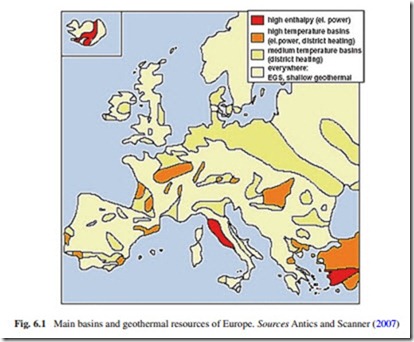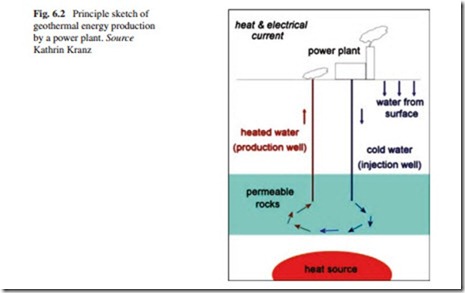Abstract Geothermal energy is a type of energy stored in the form of heat beneath the surface of the solid earth. The use of geothermal energy depends on the temperature of the geothermal fluid. If this temperature is below 180º, then the most efficient use of the geothermal sources is in domestic heating or for heating the water. If the temperature of the geothermal fluid is 180º or above, then the energy associated with the geothermal fluid can be used for electricity generation. There is no geographical restriction to the exploitation of geothermal energy, as the source is present everywhere. However, some regions benefit from more favorable conditions that allow an earlier development of geothermal resources, under more economical conditions, using current available technology. As a consequence, the majority of the geothermal power plants in Europe are located in Italy, Iceland, and Turkey, where unusually high temperatures at comparatively limited depth dominate.
Introduction
Geothermal1 energy is a type of energy stored in the form of heat beneath the surface of the solid earth. The use of geothermal energy depends on the temperature of the geothermal fluid. If this temperature is below 180°, then the most efficient use of the geothermal sources is in domestic heating or for heating the water. If the temperature of the geothermal fluid is 180° or above, then the energy associated with the geothermal fluid can be used for electricity generation.
Geothermal energy has been used for district heating in France during the Middle Ages, and for extracting various borate compounds at Lardarello, Italy, starting in the 1700s. More recently, extensive direct heat utilization projects have been undertaken in many European countries, and electric power developed extensively in Italy and Iceland. Geothermal heat pumps became extensively used also in Austria, Switzerland, Germany, and Sweden (Antics and Scanner 2007).
Geothermal energy utilization is neither new nor negligible. The first electricity production happened as early as 1907 in the Italian village Larderello, and today, more than 72 GWh is generated per year worldwide. Nevertheless, this fig- ure is still small compared with the enormous theoretical potential. There is no geographical restriction to the exploitation of geothermal energy, as the source is present everywhere. However, some regions benefit from more favorable conditions that allow an earlier development of geothermal resources, under more economical conditions, using currently available technology. As a consequence, the majority of the geothermal power plants in Europe are located in Italy, Iceland, and Turkey, among others. Europe has significant geothermal resources, both in volcanic and sedimentary basin environment (See Fig. 6.1).
According to Fig. 6.1, thermal and geological conditions result in the fact that Europe possesses mostly low-enthalpy resources. They are predominantly found in sedimentary formations. However, at attainable depths in several regions, high-enthalpy resources are also found, as in Iceland, Italy, Turkey, Greece, Portugal (Azores), Russia (Kamchatka), Spain (the Canary Islands), and at some other islands and overseas territories of France (Guadeloupe). The main
geothermal fields under exploitation are in the Larderello region (Italy); the Paris Basin (France); the Pannonian Basin (Hungary, Serbia, Slovakia, Slovenia, and Romania); several sectors of the European Lowland (Germany and Poland); the Palaeogene systems of the Carpathians (Poland and Slovakia); and other Alpine and older structures of Southern Europe (Bulgaria, Romania, and Turkey) (Ke˛pin´ska 2008).
The general principle of geothermal energy production is shown in Fig. 6.2; the functioning of the site differs depending on the particular geothermal type. Areas where geothermal resources have not been identified are so-called “cold areas” (Loftsdottir and Thorarinsdottir 2006). According to Flòvenz (2006), geothermal resources are divided into conventional fields—including high- and low-temperature areas—and unconventional fields, which are subdivided into petrothermal systems (often called “EGS or HDR”) and supercritical geothermal systems (SGS). Almost all geothermal power plants in the world are conventional, and they differ in their geological properties and tectonical location.
Conventional Fields
According to Kranz (2007), in conventional fields, the high-temperature areas are directly linked to active volcanic systems or along their periphery. Thus, the heat sources are in general shallow magma intrusions. There, the water temperature is not less than 200–250 °C within one km depth. Due to the location on high ground and the high permeability of the rather young rock material, the ground water table is comparatively deep. The ground water itself is assumed to be mostly of meteoric origin and to undergo density-driven vertical circulation. Being heated in the underground, the water is able to dissolve various minerals. These substances are well utilized in research on geothermal energy. Due to the high content of dis- solved minerals and gases, the water from high-temperature resources cannot be utilized directly for heating. Nevertheless, the high steam pressure and high temperature are well suited for heating up freshwater as a hot water supply and for generating electricity with conventional turbines.
By contrast, the low-temperature areas can be found in the areas flanking the active volcanic zone—that is outside the active zone. The water temperature decreases with distance from the volcanic belt and is always below 150–100 °C at a depth of one km. As a result of the rather low temperature, the concentration of minerals and gases is low enough to use the water directly for hot water supply. In addition to that, it is mainly used directly for heating purposes. Due to the better conditions, the vegetation often reaches up to the banks. Like high-temperature areas, also low-temperature areas are in most cases marked by water of meteoric origin. Nevertheless, the faults and fractures caused by tectonic activity play another essential role by providing channels for the circulating water. These systems are often characterized by a great horizontal extension and constitute practically steady-state phenomena. The most powerful systems are believed to be transient, as they are localized to convection systems with water undergoing vertical circulation in fractures several kilometers deep: The heat of the deeper rocks is then washed out at a much faster rate than it is renewed by conduction from the surroundings; so the geothermal activities of this areas draws to a close after some thousands of years (Anonymous VI; Bjornsson 2006; Flòvenz 2006; Gunnlaugsson et al. 2000; Loftsdottir and Thorarinsdottir 2006; Ragnarsson 2000).
Sometimes, an additional category for conventional fields is included— medium-temperature areas. These fields are marked by water temperatures between 150 and 200 °C. Not only high flow rates, but also binary systems—more complex and expensive equipment in comparison with conventional turbines—are needed for electricity production (Flòvenz 2006).
Unconventional Fields
Even in case of the absence of groundwater, geothermal energy can be utilized: Petrothermal systems, which are often called “Enhanced geothermal systems (EGS)” or “Hot dry rock systems (HDR),” are based on hydraulically broken fissures, in which water is artificially forced into. Due to the enhanced permeability, the water is able to circulate between the boreholes (see Fig. 6.2). These unconventional geothermal systems can be used for production of both heat and electricity. After some decades, petrothermal reservoirs are cooled down and can be used after a heat recovery time of some decades or centuries again. These systems are still a subject to research, but they are believed to be suitable for improving the output of conventional medium-temperature areas (Flòvenz 2006).
Another type of unconventional geothermal energy is the so-called “Supercritical geothermal systems (SGS)”, which are characterized by supercritical hydrous gases having very low density and viscosity and thus extremely high flow rates. These fluids are the only phases existing at temperatures and pressures above the critical point, which occurs at 374.15 °C and 221.2 bars for pure water and slightly higher in waters with dissolved components. These systems can be found at greater depths below water-dominated, conventional high-temperature areas, approximately in 3.5–5 km depth.

